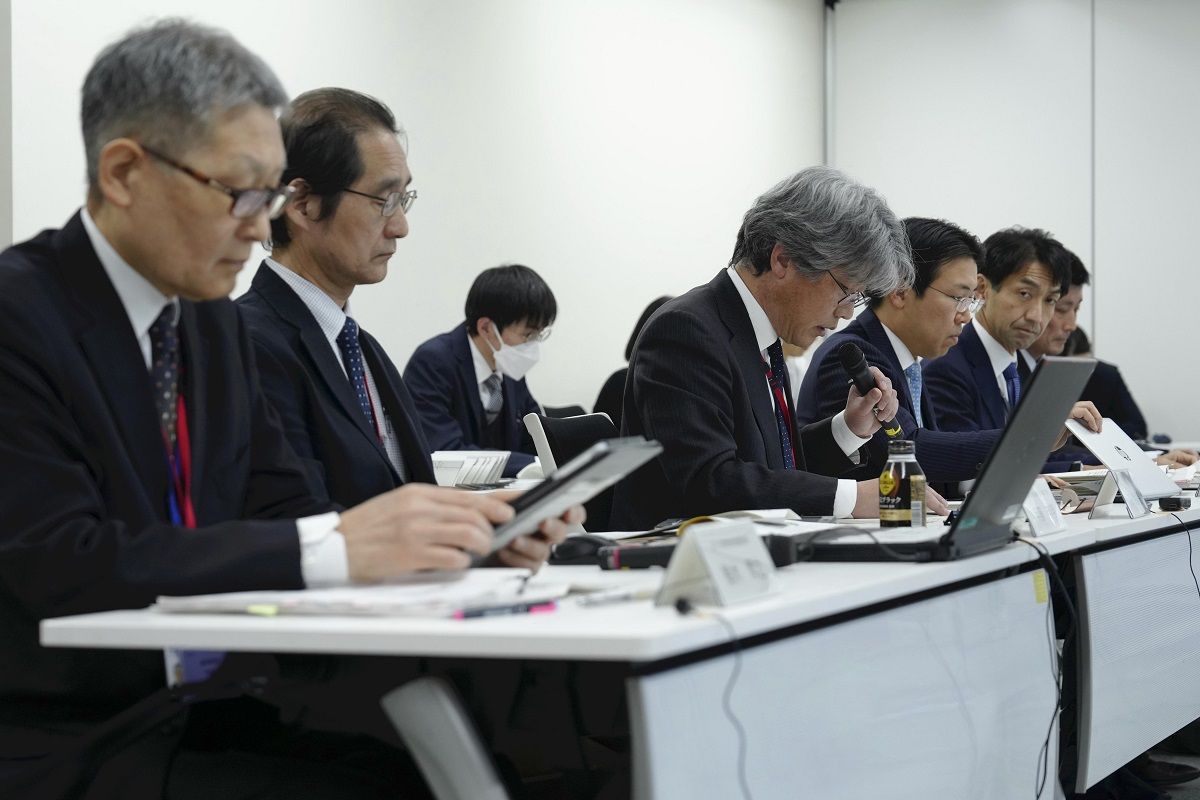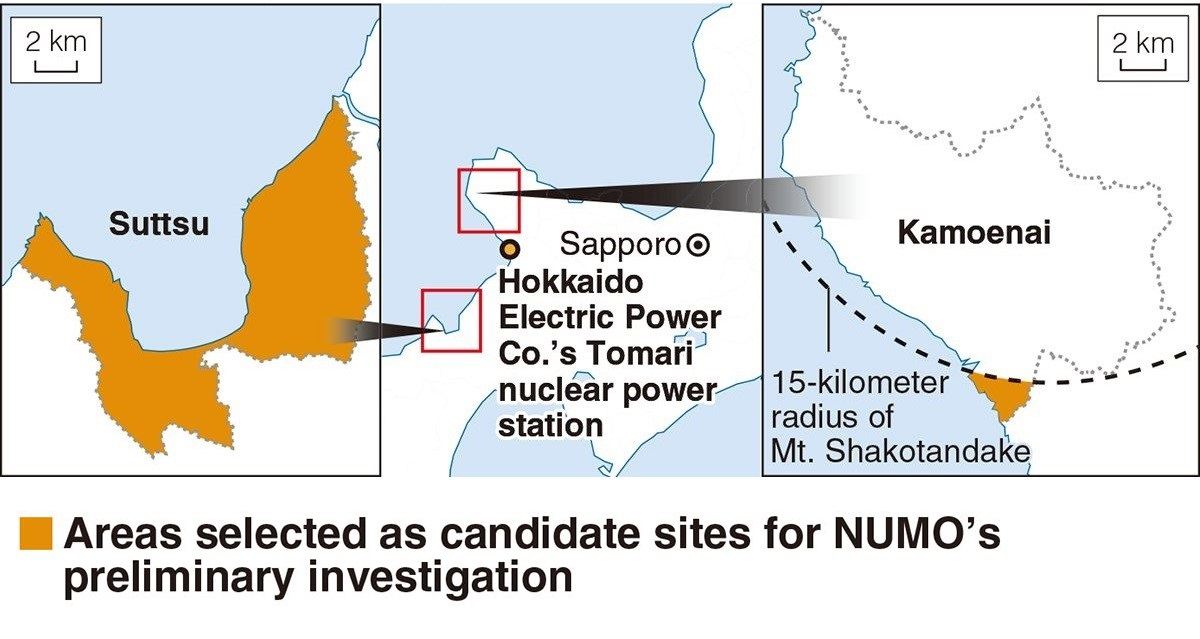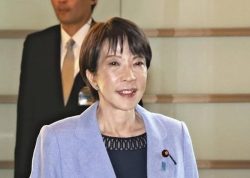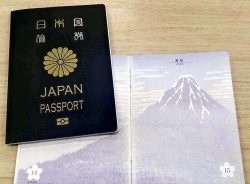Project to Choose Nuclear Waste Disposal Site Moves Forward, But Work Still Needed to Gain Consent of Residents, Governor

A Tuesday meeting of the Economy, Trade and Industry Ministry panel that received a draft report on a survey for the selection of a final disposal site for radioactive waste
21:00 JST, February 14, 2024
Japan’s project to dispose of highly radioactive nuclear waste has moved a step forward, with two areas of Hokkaido being named as candidates for the second stage of the process to select final disposal sites. However, it is still unclear whether the consent of local residents can be obtained.
The Nuclear Waste Management Organization of Japan (NUMO), a corporation authorized by the economy, trade and industry minister, released a draft report of its “literature” survey — the first part of the three-stage process to select geographical disposal sites — on the Hokkaido town of Suttsu and the village of Kamoenai. According to NUMO, both areas can be candidates for the second-stage survey.
Highly radioactive waste from the reprocessing of spent fuel used in nuclear power plants is vitrified and confined in stable host rock formations more than 300 meters underground. The final disposal site is determined through three steps: a “literature survey” to determine the history of volcanic activity and other factors; a “preliminary investigation” to check geological structures by excavating a limited area; and a “detailed investigation” to build underground facilities for research.
The second stage is expected to take about four years, and the third stage about 14 years.
Survey stretched to 3 years
In November 2020, NUMO launched the literature survey in Suttsu and Kamoenai, its first such attempt nationwide. Taking into account factors such as earthquakes, eruptions, uplift and erosion, it examined a total of 1,600 reference materials, including existing geological data and academic papers.
As a result, the entire area of Suttsu was selected as a candidate site for the following preliminary investigation. In contrast, only 3 to 4 square kilometers of the southern end of Kamoenai were selected because most of the village falls within a 15-kilometer radius of Mt. Shakotandake in the village’s northeast, which could be affected by volcanic activity.
The literature survey was intended to last two years but ultimately took more than three.
“In addition to being the first attempt of its kind in Japan, it took time to establish objective evaluation criteria and make a fair judgment,” NUMO said.

Governor opposed
The draft report will now be discussed by an economy ministry panel, and then sent to the mayors of both municipalities and Hokkaido Gov. Naomichi Suzuki.
The consent of the mayors and Suzuki must be obtained before moving on to the preliminary investigation. At a Tuesday press conference in the Kamoenai village office, Mayor Masayuki Takahashi said, “Although there was a considerable delay, we accept this as the result of a careful investigation.”
Suttsu Mayor Haruo Kataoka said to The Yomiuri Shimbun, “I have nothing to tell you at this stage.”
Both mayors have suggested the possibility of a referendum, saying they would like to make a decision after hearing the opinion of their residents and may decide based on the results. There are residents in both municipalities who oppose the project, but these voices have not become a strong upsurge.
However, Suzuki has maintained his opposition based on a Hokkaido ordinance that states nuclear waste is “unpalatable.” He issued a comment Tuesday stating, “I intend to express my opposition.”
The hurdles to proceeding to a preliminary investigation are getting higher.
Central government in a hurry
The central government began publicly soliciting candidate municipalities in 2002, but only Suttsu and Kamoenai have been surveyed.
Last year, the government switched its policy from “reducing dependence on nuclear power plants as much as possible” to actively utilizing them to ensure a stable power supply. Amid the growing need to establish disposal sites, the government has been alarmed by the lack of candidate sites.
The government indicated in April its intention to “take responsibility” for selecting a disposal site, and authorities have visited 73 municipalities to seek their understanding of accepting a survey.
The government hopes to narrow down the list from about 10 candidate sites, and municipalities that accept the survey will receive a subsidy. However, many municipalities have not responded to the dialogue.
The Tsushima city government was considering accepting a literature survey, but announced last year that it would not due to difficulties in building consensus among residents.
Chief Cabinet Secretary Yoshimasa Hayashi told reporters Tuesday, “We will continue to carefully and steadily proceed with the process by carefully listening to the voices of the local community and explaining the situation to them.”
"Politics" POPULAR ARTICLE
-

Japan to Support Central Asian Logistics Route That Bypasses Russia, Plan to Be Part of Upcoming Summit in Tokyo
-

Japan to Tighten Screening of Foreigners’ Residential Status by Providing Information of Nonpayment of Taxes
-

Chinese, Russian Bombers Flew Unusual Path by Heading Toward Tokyo; Move Likely Meant to Intimidate Japan
-

Japan Plans National Database to Track Foreign Ownership of Real Estate, Land as It Weighs New Rules
-

Up to 199,000 Deaths Estimated From Mega-Tsunami; Most Recent Occurrence Took Place in 17th Century
JN ACCESS RANKING
-

Tokyo Economic Security Forum to Hold Inaugural Meeting Amid Tense Global Environment
-

Keidanren Chairman Yoshinobu Tsutsui Visits Kashiwazaki-Kariwa Nuclear Power Plant; Inspects New Emergency Safety System
-

Imports of Rare Earths from China Facing Delays, May Be Caused by Deterioration of Japan-China Relations
-

University of Tokyo Professor Discusses Japanese Economic Security in Interview Ahead of Forum
-

Japan Pulls out of Vietnam Nuclear Project, Complicating Hanoi’s Power Plans























